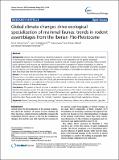Por favor, use este identificador para citar o enlazar a este item:
http://hdl.handle.net/10261/76390COMPARTIR / EXPORTAR:
 SHARE SHARE
 CORE
BASE CORE
BASE
|
|
| Visualizar otros formatos: MARC | Dublin Core | RDF | ORE | MODS | METS | DIDL | DATACITE | |

| Campo DC | Valor | Lengua/Idioma |
|---|---|---|
| dc.contributor.author | Gómez Cano, Ana R. | - |
| dc.contributor.author | Cantalapiedra, Juan L. | - |
| dc.contributor.author | Mesa, Aurora | - |
| dc.contributor.author | Moreno Bofarull, Ana | - |
| dc.contributor.author | Hernández Fernández, M. | - |
| dc.date.accessioned | 2013-05-20T19:05:08Z | - |
| dc.date.available | 2013-05-20T19:05:08Z | - |
| dc.date.issued | 2013-04-30 | - |
| dc.identifier.citation | BMC Evolutionary Biology 13(1) : 94- (2013) | - |
| dc.identifier.uri | http://hdl.handle.net/10261/76390 | - |
| dc.description.abstract | Background: Several macroevolutionary hypotheses propose a synchrony between climatic changes and variations in the structure of faunal communities. Some of them focus on the importance of the species ecological specialization because of its effects on evolutionary processes and the resultant patterns. Particularly, Vrba’s turnover pulse hypothesis and resource-use hypothesis revolve around the importance of biome inhabitation. In order to test these hypotheses, we used the Biomic Specialization Index, which is based on the number of biomes occupied by each species, and evaluated the changes in the relative importance of generalist and specialist rodents in more than forty fossil sites from the Iberian Plio-Pleistocene. Results: Our results indicate that there was a decrease in the specialization degree of rodent faunas during the Pliocene due to the global cooling that triggered the onset of the glacial events of the Cenozoic (around 2.75 Ma). The subsequent faunal transition after this critical paleoenvironmental event was characterized by an increase of specialization related to the adaptation to the new environmental conditions, which was mainly associated with the Pleistocene radiation of Arvicolinae (voles). Conclusions: The pattern of faunal turnover is correlated with the development of the modern glaciations in the Northern Hemisphere around 2.75 Ma, and represents a reorganization of the rodent communities, as suggested by the turnover pulse hypothesis. Our data also support the resource-use hypothesis, which presumes the role of the degree of specialization in resources specifically related to particular biomes as a driver of differential speciation and extinction rates. These results stress the intimate connection between ecological and evolutionary changes. | - |
| dc.description.sponsorship | We acknowledge financial support from the Spanish Ministry of Science and Innovation, through the projects CGL2006-01773/BTE and CGL2010-19116/BOS. The authors also thank the Unit of Information Resources for Research (URICI-CSIC) for the co-financing of this publication in Open Access. | - |
| dc.language.iso | eng | - |
| dc.publisher | BioMed Central | - |
| dc.relation.isversionof | Publisher's version | - |
| dc.rights | openAccess | - |
| dc.subject | Biome | - |
| dc.subject | Community | - |
| dc.subject | Evolutionary ecology | - |
| dc.subject | Generalist | - |
| dc.subject | Glaciations | - |
| dc.subject | Habitat theory | - |
| dc.subject | Macroevolution | - |
| dc.subject | Specialist | - |
| dc.title | Global climate changes drive ecological specialization of mammal faunas: trends in rodent assemblages from the Iberian Plio-Pleistocene | - |
| dc.type | artículo | - |
| dc.identifier.doi | 10.1186/1471-2148-13-94 | - |
| dc.description.peerreviewed | Peer Reviewed | - |
| dc.relation.publisherversion | http://www.biomedcentral.com/1471-2148/13/94 | - |
| dc.date.updated | 2013-05-20T19:05:08Z | - |
| dc.rights.license | http://creativecommons.org/licenses/by/2.0 | - |
| dc.relation.csic | Sí | - |
| dc.identifier.pmid | 23627696 | - |
| local.message.claim | 2024-01-19T12:54:18.693+0100|||rp15251|||submit_approve|||dc_contributor_author|||None | * |
| dc.type.coar | http://purl.org/coar/resource_type/c_6501 | es_ES |
| item.languageiso639-1 | en | - |
| item.fulltext | With Fulltext | - |
| item.openairecristype | http://purl.org/coar/resource_type/c_18cf | - |
| item.cerifentitytype | Publications | - |
| item.grantfulltext | open | - |
| item.openairetype | artículo | - |
| Aparece en las colecciones: | (MNCN) Artículos (IGEO) Artículos | |
Ficheros en este ítem:
| Fichero | Descripción | Tamaño | Formato | |
|---|---|---|---|---|
| 1471-2148-13-94.xml | 88,9 kB | XML | Visualizar/Abrir | |
| 1471-2148-13-94.pdf | 809,36 kB | Adobe PDF |  Visualizar/Abrir |
CORE Recommender
PubMed Central
Citations
6
checked on 21-abr-2024
SCOPUSTM
Citations
17
checked on 16-abr-2024
WEB OF SCIENCETM
Citations
17
checked on 23-feb-2024
Page view(s)
338
checked on 23-abr-2024
Download(s)
412
checked on 23-abr-2024

